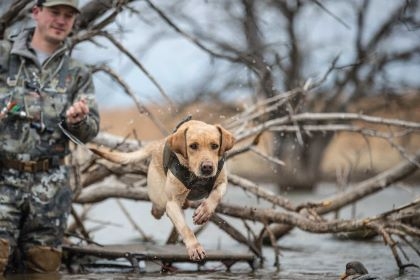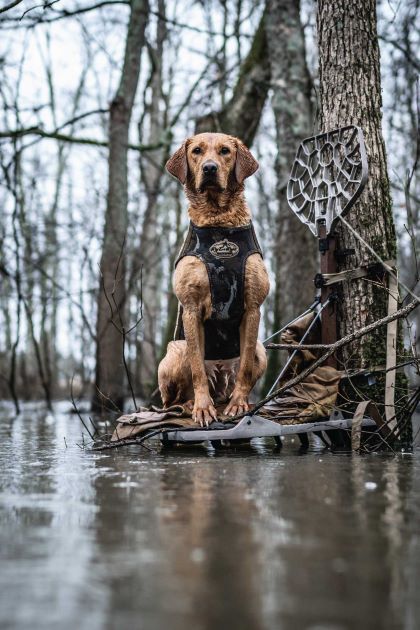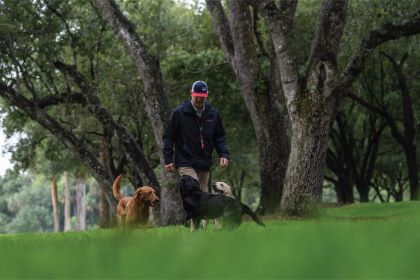Mid-Season Training Corrections for Retrievers

You trained all spring and summer. Your dog performed perfectly during the early season. But then a cold front moved in and the duck and goose migration kicked into high gear.
Mid-Season Training Corrections for Retrievers
Written by Tom Keer
You trained all spring and summer. Your dog performed perfectly during the early season. But then a cold front moved in and the duck and goose migration kicked into high gear. That fired up your ordinarily calm dog to the point that he whined and broke and ruined the morning’s hunt. All dogs get excited and make mistakes, so here’s how to get them refocused without having to return to the training fields.
Robert Milner, the owner of Duckhill Kennels says “the excitement in a blind causes dogs to produce adrenalin, endorphins and other neurochemicals. Those hormones put them in a state of excitement. Fortunately, hormones dissipate faster than they are created. It takes three minutes for these neurochemicals to reduce and for the dog to relax. Behavior improves when they are calm, and that’s when they should be rewarded with a retrieve.
 According to Robert Milner of Duckhill Kennels, steadiness comes from calm dogs. It’s important for good blind manners.
According to Robert Milner of Duckhill Kennels, steadiness comes from calm dogs. It’s important for good blind manners.“To get an over-excited dog back on track I make him wait for three minutes before sending him on a retrieve,” Robert says. If he hasn’t calmed down and regained his focus then I’ll give the work to an obedient dog. I’ll repeat that method as often as necessary until the excited dog is calm. It might take five or more repetitions for young dogs and maybe only one or two corrections for experienced dogs. The point is to repeat as many times as necessary.
“I’ll also send dogs that are wound up on long retrieves,” he continues. “The same rush of adrenaline that excited the dog in the first place now motivates him to run and swim hard. Vigorous work on a long retrieve helps burn off some of those hormones, so when he returns to the blind he’s calmer than when he left. For the next retrieve I’ll build on that foundation. I make him wait for three minutes before sending him to fetch. Rewarding calmness is the foundation of good blind manners, and by pausing before sending a dog on a retrieve you’ll get your dog back on track very quickly.”
Jeremy Criscoe, a Eukanuba™ Pro Trainer and the owner of Whistling Wings Kennel, slightly changes his schedule to accommodate training and drills. “Post-hunt work is a great time to get rowdy dogs back on track. I always have some bumpers in the truck, so if a dog was difficult in the morning I’ll put him to work when we’re done. I’ll stand outside of the pit or blind, throw some marks outside of the decoys, and run some retrieves.
 Jeremy Criscoe of Whistling Wings Kennel introduces dogs to new areas ahead of a hunt.
Jeremy Criscoe of Whistling Wings Kennel introduces dogs to new areas ahead of a hunt.“A lot of times dogs get worked up and break because of the perceived competition coming from other dogs,” explains Jeremy. “Honoring drills help them relax and focus. I’ll run some drills with a buddy and his dog. I’ll get my dog under control, send his to fetch bumpers, and release mine when he’s calm and well mannered, and steady. I’ll switch up the order of which dog gets to retrieve. I might send his dog three or four times in a row to test my dog’s patience. When my dog behaves properly, I’ll send him for the reward of the retrieve. Then I’ll give my dog several retrieves while my buddy waits with his dog.
“I always try to identify issues before they become problems. I know my dogs will be excited when we hunt a new area, so I’ll familiarize them with the spot before the hunt. I’ll arrive at the new location a little early on the day before the hunt. Then, I’ll introduce the dogs to the new blinds and terrain. We’ll walk around, get in and out of the blind, and check things out. Throwing some bumpers for retrieves helps dogs get acquainted with running routes. It might only take an hour or two, but that pre-hunt exposure lets dogs get familiar with the new environment. They’re less likely to get ramped up in the morning.”
We’ve worked all year to get to hunting season. Don’t let a few mistakes derail your plan. Midseason corrections get dogs back on track so they can go hard for the rest of the year.
Tom Keer is an award-winning writer and regular contributor to over a dozen magazines and blogs. His favorite time of year is in October and November where you can find him in woodcock and grouse coverts or quail fields with his wife, two kids, and three English setters. Visit him at www.tomkeer.com or at www.thekeergroup.com.

Tom Keer is an award-winning writer and regular contributor to over a dozen magazines and blogs. His favorite time of year is in October and November where you can find him in woodcock and grouse coverts or quail fields with his wife, two kids, and three English setters. Visit him at www.tomkeer.com or at www.thekeergroup.com.



Comments